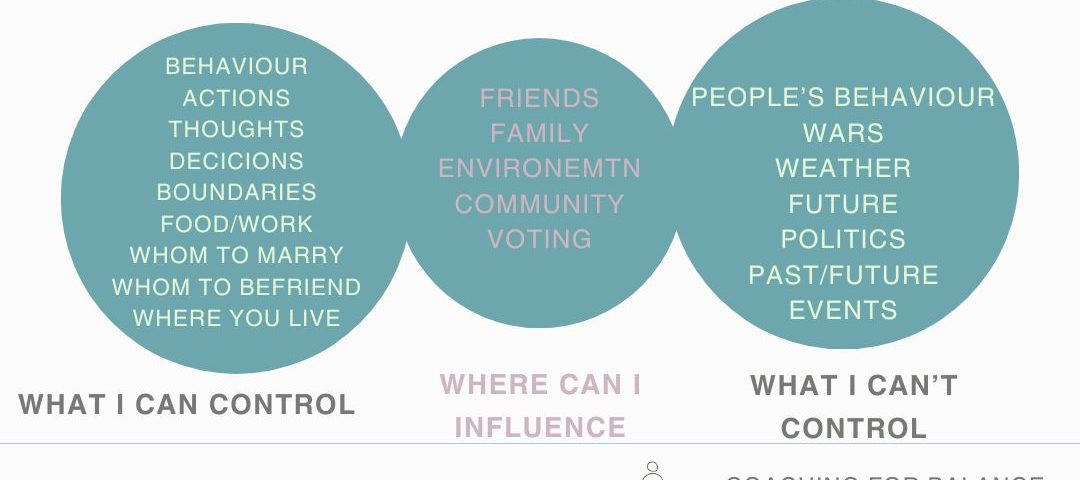
How Do You Adapt to Change?
November 10, 2024
Finding focus amidst the chaos
January 23, 2025As a mother, a professional or simply as someone trying to navigate life, have you ever felt the weight of trying to manage everything (possibly everyone too)? The truth is, many of us fall into the trap of taking on an executive role in every aspect of our lives by trying to control not only ourselves but also others and everything. This “need” to control often stems from a place of love and care, but it can also lead to tension, stress and overwhelm. Understanding the Circle of Control can be a game-changer in reducing overwhelm and fostering healthier relationships as well mental well-being.
What is the circle of control?
The Circle of Control is a powerful concept that categorizes aspects of life into three areas:
- Things we can control: Our mindset, emotions, attitudes, actions, responses, what we eat, where we work, whom to marry and befriend etc.
- Things we cannot control: Other people’s actions, behaviours, decisions and external events (like the past, future or circumstances beyond our influence).
By focusing on what we can control and letting go of what we cannot, we free ourselves from unnecessary stress and create room for growth and connection.
“Sometimes letting go is the most powerful way to show you are in control.”
Mandy Hale
The art of letting go
Letting go of control is not a sign of weakness; it’s an act of self-care and empowerment. For example:
- Parenting: Many mums try to control how their partners parent their children. While this often comes from a place of love, it can create unnecessary tension and deprive us of opportunities to step back and recharge. Allowing our partners to parent in their own way fosters trust and balance.
- Children’s behaviours and choices: We often push our children to excel in areas that may not align with their interests or passions. This pressure can stem from societal expectations or unresolved voids within ourselves. Additionally, by attempting to control their choices, we may unintentionally impose our own projections onto them, limiting their ability to build their own personalities and explore their unique potential. By trying to fix or control, we unintentionally take away their chance to discover themselves. Letting go of this control allows our children to flourish authentically and nurtures a stronger bond.
-
At Work: In the workplace, trying to control every aspect of a project or team dynamic can lead to micromanagement and unnecessary stress. For instance, imagine being part of a collaborative project and feeling the urge to ensure every detail aligns with your vision. While well-intentioned, this approach can undermine trust and hinder creativity among colleagues. Instead, by focusing on your own contributions and maintaining open communication, you allow others to bring their strengths to the table. This not only enhances the project but also builds creativity, mutual respect and collaboration.
Why do we control?
The desire to control often originates from fears, insecurities, fear of judgement or unmet expectations passed down through generations. It’s often an issue of self-acceptance; when we accept ourselves, we are more likely to accept others as they are. Tackling these internal drivers is essential for truly embracing the art of letting go. When we release the urge to control, we experience relief, enhanced communication and better mental health.
The circle of influence
This lies between what we can and cannot control. It encompasses how our actions and attitudes may inspire or influence others without direct control. While we can’t control others, we can influence them by how we show up in the world. For instance:
- Modeling behaviours such as setting and maintaining healthy boundaries teaches others in particular our children to respect their own and others’ limits.
- Exhibiting patience and understanding inspires collaboration and trust within our families and workplaces.
When we lead by example, we create a ripple effect that extends beyond our immediate circle. This is where true power lies; not in control but in influence.
A Path to Freedom and Connection
Acknowledging the boundaries of the Circle of Control can transform the way we approach life. Instead of feeling weighed down by what we cannot change, we can focus our energy into what truly matters: our own growth, attitudes and actions. This shift not only reduces overwhelm but also strengthens our relationships and deepens our connection with ourselves and others.
Letting go is an art—an act of courage and wisdom. By focusing on what we can control, we reclaim our power and model resilience and acceptance for those around us. As mothers, professionals and individuals, embracing this mindset is a gift we give ourselves and our loved ones. So, take a deep breath, step back and let go.
As we approach the end of the year, I invite you to reflect on what you’ve been holding onto that’s beyond your control. What would it feel like to release it? Let’s enter the new year with lighter hearts and open minds, mastering the art of letting go and embracing the freedom it brings.
If you find it hard to let go or are unsure how and where to start – this is where I can help.



